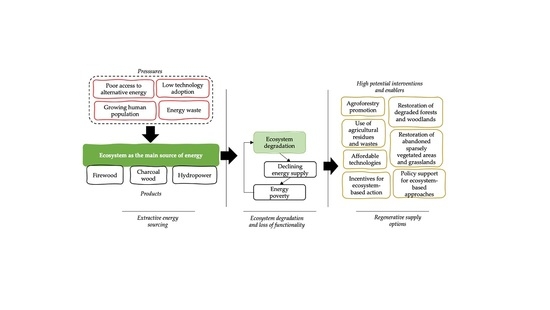Ecosystem-Based Approaches to Bioenergy and the Need for Regenerative Supply Options for Africa
Abstract
1. Introduction
2. A Conceptual Framework: Towards Regenerative Energy Supply Options
- Argument 1: Managing forests and woodlands for wood fuel is crucial: If forest conservation and management fail to save forests, biomass energy sources will shrink. When communities do not have alternative, affordable and accessible energy sources, they will go to great lengths to get wood for cooking and lighting. Hence, a failure in the system in one location can have subsequent adverse effects in surrounding areas [21,22].
- Argument 2: Managing forests and woodlands for hydrological services is critical. Forests and woody vegetation in general play a crucial role in the hydrological processes in a landscape. With forest destruction (deforestation or forest degradation), sedimentation (or siltation) becomes a significant challenge for dams and reservoirs. When dams do not hold enough water for hydropower plants, power generation becomes limited. Then those people who rely on electricity will divert to biomass resources which then increases the pressure on forests and woody vegetation [23].
- Argument 3: The high dependency on biomass energy is creating a vicious cycle of ecosystem degradation. With the current and projected high dependency on biomass energy in the next decades in Africa, unless forests and woodlands are conserved, restored, and managed, supplying energy for the wider population will remain a critical challenge. If the current state of technological advances is not improved, it will further lead to a vicious cycle of ecosystem degradation, thus, exacerbating the problem [24,25,26].
- Argument 4: Proper land use is fundamental [27]. Three dimensions can be addressed here.
- If land use in the watershed is not adequately regulated, soil erosion from upland areas leads to increased sediment accumulation in dams hence leading to Argument 2 [28].
- With poor land management, land productivity declines and consequently biomass for energy production, especially from energy crops and agricultural residues declines. This directly affects energy supply [29].
- With poor land management, livestock have limited feed sources and hence reduced biogas production potential.
- Argument 5: Soil management plays a crucial role. If soil is not properly managed in watersheds, incoming moisture through rainfall often flows on the surface, joining river systems. This leads to reduced water infiltration into the soil and therefore, weak groundwater recharge. Silt-loaded rivers in turn diminish power generation [30].
- Argument 6: Woody vegetation alone may not solve the ongoing energy scarcity on the continent [31]. Africa’s population is growing, causing rising energy demand. If woody resources depletion is not abated, forests, savannah, and woodlands alone may not be able to sustain the supply of energy for the biomass dependent continent. Thus, there is a critical need for alternative sources of energy, proactive interventions that increase woody biomass, and technologies that enhance the conversion efficiency of energy raw materials. Residues from crops allow energy generation in forms such as biodiesel, ethanol, biowaste electricity and biogas energy to supplement the available resources [32,33] and reduce the pressure on ecosystems.
- Technologies to improve on efficiency: The energy production and use system in Africa is characterized by huge wastage of raw materials and very low raw material to energy conversion ratios. For instance, the most widely used cooking method on the continent, the three-stone fire, has an energy efficiency of less than 20% [34].
- Technologies to transition to new forms of energy sources: Most of Africa’s population still relies on firewood and charcoal for energy generation. However, with appropriate technologies, a shift to solar and wind energy, which are among the cheapest energy raw materials, can be possible. To date, the access rate of such technologies in Africa is exceedingly low.
- Understanding the lifecycle analysis (footprints) of energy supply options: The energy that we use at every moment of our daily life comes at a significant environmental cost. For instance, generating one gigajoule (GJ) of energy from charcoal comes with a water footprint of about 53 m3 [35]. Similarly, generating the same amount of energy from firewood (non-coniferous) comes with a water footprint of 21 m3. Even further, the extraction of charcoal and firewood often causes deforestation and forest degradation, which subsequently threatens the habitat values of ecosystems and hence damages biodiversity.
3. Materials and Methods
3.1. The Scope of the Research
3.2. Estimating the Ecosystem’s Role in Supplying Energy
3.3. Estimating the Potential of Landscape Restoration to Boost Energy Supply in Africa
3.4. Estimating Energy Potential from Sparsely Natural Vegetated Areas
3.5. Estimation of the Potential of Crop Residues to Boost Energy Supply in Africa
4. Results
4.1. Ecosystems as Prime Sources of Bioenergy in Africa
4.1.1. Firewood
4.1.2. Charcoal Wood
4.1.3. Hydropower
4.2. Estimating Potentials of Ecosystem-Based Approaches to Bioenergy
4.2.1. Ecosystem Restoration with Bioenergy Co-Benefits
4.2.2. Trees on Farm (Agroforestry) Promotion
4.2.3. Agricultural Residue and Waste for Bioenergy Generation
5. Discussions
5.1. Policy Mechanisms for Ecosystem-Based Approaches to Bioenergy
5.2. Multisectoral Engagement and Multi-Institutional Roles
5.3. Enforcement of Rules, Regulations and Provisions Relevant to Sustainable Bioenergy
5.4. A SWOT Overview of Ecosystem-Based Bioenergy Interventions
6. Conclusions
Author Contributions
Funding
Acknowledgments
Conflicts of Interest
Appendix
| Crop Type/Residues | Average Annual Production (Tonnes) (2013–2018) | Crop to Residue Ratio (CRR) | Residue Quantity (Tonnes) | Energy Content (GJ Per Tonne of Residue | Total Energy Potential (GJ) |
|---|---|---|---|---|---|
| Cassava | 168,741,314 | 17.50 [83] | |||
| Stalk | 0.062 [84] | 10,461,961 | 183,084,32 | ||
| Sugarcane | 93,947,960 | 16.60 [83] | |||
| Tops and leaves | 0.05 [84] | 4,697,398 | 77,976,807 | ||
| Bagasse | 0.2 [84] | 18,789,592 | 311,907,227 | ||
| Maize | 76,864,067 | 12.46 [83] | |||
| Stalk | 2 [84] | 153,728,133 | 1,915,452,541 | ||
| Cob | 0.3 [84] | 23,059,220 | 287,317,881 | ||
| Husk | 0.2 [84] | 15,372,813 | 191,545,254 | ||
| Rice (paddy) | 31,443,455 | 13.45 [83] | |||
| Stalk | 1.5 [84] | 47,165,182 | 634,371,698 | ||
| Husk | 0.2 [84] | 6,288,691 | 84,582,893 | ||
| Straw | 1.5 [84] | 47,165,182 | 634,371,698 | ||
| Sorghum | 28,046,572 | 112.38 [83] | |||
| Straw | 1.25 [84] | 35,058,215 | 434,020,699 | ||
| Wheat | 26,988,159 | 17.00 [83] | |||
| Stalk | 1.5 [84] | 40,482,238 | 688,198,042 | ||
| Straw | 1.75 [84] | 47,229,277 | 802,897,715 | ||
| Pod | 0.3 [84] | 8,096,448 | 137,639,608 | ||
| Potatoes | 25,468,619 | 17.50 [83] | |||
| Stalk | 0.05 [83] | 1,273,431 | 22,285,042 | ||
| Tops and leaves | 0.76 [83] | 19,356,151 | 338,732,637 | ||
| Sweet potatoes | 25,311,996 | 17.50 [83] | |||
| Stalk | 0.1 [83] | 2,531,200 | 44,295,993 | ||
| Oil palm fruit | 18,957,246 | 13.26 [85] | |||
| Shell | 0.065 [84] | 1,232,221 | 16,339,250 | ||
| Fiber | 0.13 [84] | 2,464,442 | 32,678,501 | ||
| Brunches | 0.23 [84] | 4,360,167 | 57,815,809 | ||
| Groundnuts | 13,405,969 | 18.80 [85] | |||
| Stalk | 2 [84] | 26,811,937 | 504,064,416 | ||
| Husk | 0.0477 [84] | 6,394,647 | 120,219,363 | ||
| Straw | 2.3 [84] | 30,833,728 | 579,674,078 | ||
| Shell | 0.3 [84] | 4,021,791 | 75,609,662 | ||
| Millet | 13,068,719 | 20.00 [86] | |||
| Stalk | 1.2 [84] | 15,682,463 | 313,649,260 | ||
| Straw | 1.75 [84] | 22,870,259 | 457,05,171 | ||
| Onions | 11,391,042 | 10.49 [87] | |||
| Stalk | 0.05 [83] | 569,552 | 5,974,601 | ||
| Barley | 6,747,088 | 17.00 [84] | |||
| Stalk | 1.3 [84] | 8,771,214 | 149,110,641 | ||
| Straw | 1.75 [84] | 11,807,404 | 200,725,863 | ||
| Cow peas | 6,631,827 | 2.9 [84] | 19,232,299 | 15.00 [83] | 288,484,482 |
| Beans | 6,572,402 | 16.00 [83] | |||
| Stalk | 0.5 [85] | 3,286,201 | 52,579,212 | ||
| Cotton (seed) | 4,467,498 | 17.65 [88] | |||
| Stalk | 2.9 [84] | 15,859,616 | 279,922,225 | ||
| Soybean | 2,748,016 | 15.00 [89] | |||
| Stalk | 1.7 [84] | 4,671,627 | 70,074,412 | ||
| Straw | 3.94 [84] | 10,827,184 | 162,407,755 | ||
| Coconut | 2,050,956 | 17.40 [83] | |||
| Husk | 1.6 [84] | 3,281,530 | 57,098,620 | ||
| Shell | 0.12 [84] | 246,115 | 4,282,396 | ||
| Coffee | 1,137,476 | 12.69 [83] | |||
| Husk | 21 [84] | 23,886,996 | 303,125,979 | ||
| Total | 563,990,378 | 697,866,522 | 10,519,921,758 |
References
- Jonas, H.; Abram, N.K.; Ancrenaz, M. Addressing the Impact of Large-Scale Oil Palm Plantations on Orangutan Conservation in Borneo: A Spatial, Legal and Political Economy Analysis; IIED: London, UK, 2017; p. 94. [Google Scholar]
- Duguma, L.A.; Minang, P.A.; Freeman, O.E.; Hager, H. System wide impacts of fuel usage patterns in the Ethiopian highlands: Potentials for breaking the negative reinforcing feedback cycles. Energy Sustain. Dev. 2014, 20, 77–85. [Google Scholar] [CrossRef]
- Samarakoon, S. A justice and wellbeing centered framework for analysing energy poverty in the Global South. Ecol. Econ. 2019, 165, 106385. [Google Scholar] [CrossRef]
- Howe, C.; Suich, H.; van Gardingen, P.; Rahman, A.; Mace, G.M. Elucidating the pathways between climate change, ecosystem services and poverty alleviation. Curr. Opin. Environ. Sustain. 2013, 5, 102–107. [Google Scholar] [CrossRef]
- Duguma, L.A.; Minang, P.A. Levering landscapes: A systems approach to drivers of change. In Climate-Smart Landscapes: Multifunctionality in Practice; Minang, P.A., van Noordwijk, M., Freeman, O.E., Mbow, C., de Leeuw, J., Catacutan, D., Eds.; World Agroforestry Centre (ICRAF): Nairobi, Kenya, 2015; pp. 135–149. [Google Scholar]
- Meadows, D.H. Thinking in Systems: A Primer; Chelsea Green Publishing: White River Junction, VT, USA, 2008. [Google Scholar]
- International Energy Agency (IEA). World Energy Outlook 2016; International Energy Agency: Paris, France, 2016. [Google Scholar]
- Mohammed, Y.S.; Bashir, N.; Mustafa, M.W. Overuse of wood-based bioenergy in selected sub-Saharan Africa countries: Review of unconstructive challenges and suggestions. J. Clean. Prod. 2015, 96, 501–519. [Google Scholar] [CrossRef]
- Lewis, J.J.; Pattanayak, S.K. Who Adopts Improved Fuels and Cookstoves? A Systematic Review. Environ. Health Perspect. 2012, 120, 637–645. [Google Scholar] [CrossRef] [PubMed]
- Malla, S.; Timilsina, G.R. Household Cooking Fuel Choice and Adoption of Improved Cookstoves in Developing Countries: A Review; The World Bank: Washington, DC, USA, 2014. [Google Scholar]
- Walekhwa, P.N.; Mugisha, J.; Drake, L. Biogas energy from family-sized digesters in Uganda: Critical factors and policy implications. Energy Policy 2009, 37, 2754–2762. [Google Scholar] [CrossRef]
- Tigabu, A.D. Analysing the diffusion and adoption of renewable energy technologies in Africa: The functions of innovation systems perspective. Afr. J. Sci. Technol. Innov. Dev. 2017, 10, 615–624. [Google Scholar] [CrossRef]
- Ruiz-Mercado, I.; Masera, O.; Zamora, H.; Smith, K.R. Adoption and sustained use of improved cookstoves. Energy Policy 2011, 39, 7557–7566. [Google Scholar] [CrossRef]
- Mang, P.; Reed, B. Regenerative Development and Design. In Encyclopedia of Sustainability Science and Technology, 1st ed.; Regenesis group and Story of Place Institute; Chapter 303; Meyers, R.A., Ed.; Springer: New York, NY, USA, 2012; pp. 8855–8879. Available online: https://www.researchgate.net/publication/273379786_Regenerative_Development_and_Design (accessed on 14 October 2020). [CrossRef]
- U.S. Energy Information Administration (EIA); Government Publications Office. International Energy Outlook 2016, with Projections to 2040; Government Printing Office: Washington, DC, USA, 2016.
- Owen, M.; van der Plas, R.; Sepp, S. Can there be energy policy in Sub-Saharan Africa without biomass? Energy Sustain. Dev. 2013, 17, 146–152. [Google Scholar] [CrossRef]
- Fullerton, J. Regenerative Capitalism; Capital Institute: Greenwich, CT, USA, 2015. [Google Scholar]
- Liu, J.; Mooney, H.A.; Hull, V.; Davis, S.J.; Gaskell, J.; Hertel, T.W.; Lubchenco, J.; Seto, K.C.; Gleick, P.; Kremen, C.; et al. Systems integration for global sustainability. Science 2015, 347, 1258832. [Google Scholar] [CrossRef]
- Reed, B. Shifting from ‘sustainability’ to regeneration. Build. Res. Inf. 2007, 35, 674–680. [Google Scholar] [CrossRef]
- Baral, H.; Holmgren, P. A Framework for Measuring Sustainability Outcomes for Landscape Investments; Centre for International Forestry Research: Bogor, Indonesia, 2015; Volume 195. [Google Scholar]
- Jin, S.L.; Schure, J.; Ingram, V.; Byoung, I.I. Sustainable Woodfuel for Food Security; A Smart Choice: Green, Renewable and Affordable; Food and Agriculture Organization: Rome, Italy, 2017. [Google Scholar]
- Chesterman, S.; Neely, C.; Kimaro, K.; Njenga, M. Sustainable Woodfuel (Charcoal and Firewood) Systems in the Coastal Regions in Tanzania; Climate Technology Centre and Network: Copenhagen, Denmark, 2018; Available online: https://www.ctc-n.org/sites/www.ctc-n.org/files/resources/sustainablewoodfuelsystems.pdf (accessed on 10 July 2020).
- Carvalho-Santos, C.; Honrado, J.P.; Hein, L. Hydrological services and the role of forests: Conceptualization and indicator-based analysis with an illustration at a regional scale. Ecol. Complex. 2014, 20, 69–80. [Google Scholar] [CrossRef]
- Ujih, U.O.; Sabiu, N.; Musa, D.M.; Azare, I.M. Effects of fuel wood exploitation on the environment: A case study of Nasarawa local government area, Nasarawa state, Nigeria. Dutse J. Pure Appl. Sci. 2016, 2, 195–201. [Google Scholar]
- Orimoogunje, O.O.; Asifat, J. Fuel Wood Consumption and Species Degradation in South-Western Nigeria: The Ecological Relevance. J. Landsc. Ecol. 2015, 8, 56–68. [Google Scholar] [CrossRef]
- Specht, M.J.; Pinto, S.R.R.; Albuquerque, U.P.; Tabarelli, M.; Melo, F.P. Burning biodiversity: Fuelwood harvesting causes forest degradation in human-dominated tropical landscapes. Glob. Ecol. Conserv. 2015, 3, 200–209. [Google Scholar] [CrossRef]
- Gissi, E.; Siciliano, G.; Reho, M. Biomass production and land use management in the Italian context: Regulations, conflicts, and impacts. In Proceedings of the 51st Congress of the European Regional Science Association: “New Challenges for European Regions and Urban Areas in a Globalised World”, Barcelona, Spain, 30 August–3 September 2011. [Google Scholar]
- Postel, S.L.; Thompson, B.H., Jr. Watershed Protection: Capturing the Benefits of Nature’s Water Supply Services. Nat. Resour. Forum 2005, 29, 98–108. Available online: https://onlinelibrary.wiley.com/doi/pdf/10.1111/j.1477-8947.2005.00119.x (accessed on 14 October 2020). [CrossRef]
- IPCC. Climate Change and Land: An IPCC Special Report on Climate Change, Desertification, Land Degradation, Sustainable Land Management, Food Security, and Greenhouse Gas Fluxes in Terrestrial Ecosystems; Shukla, P.R., Skea, J., Buendia, C.E., Masson-Delmotte, V., Pörtner, H.O., Roberts, D.C., Zhai, P., Slade, R., Connors, S., van Diemen, R., et al., Eds.; Intergovernmental Panel on Climate Change: Geneva, Switzerland, 2019; (In press). Available online: https://www.ipcc.ch/site/assets/uploads/sites/4/2020/02/SPM_Updated-Jan20.pdf (accessed on 14 October 2020).
- Shaxson, F.; Barber, R. Optimizing Soil Moisture for Plant Production: The Significance of Soil Porosity; Food and Agriculture Organization: Rome, Italy, 2003. [Google Scholar]
- IRENA. Bioenergy from Degraded Land in Africa: Sustainable and Technical Potential under Bonn Challenge Pledges; International Renewable Energy Agency: Abu Dhabi, UAE, 2017. [Google Scholar]
- Jiang, Y.; Havrysh, V.; Klymchuk, O.; Nitsenko, V.; Balezentis, T.; Streimikiene, D. Utilization of Crop Residue for Power Generation: The Case of Ukraine. Sustainability 2019, 11, 7004. [Google Scholar] [CrossRef]
- Broadhead, J.; Killmann, W. Forests and Energy: Key Issues; Number 154; Food and Agriculture Organization: Rome, Italy, 2008. [Google Scholar]
- Makungwa, S.D.; Epulani, F.; Woodhouse, I.H. Fuelwood supply: A missed essential component in a food security equation. J. Food Secur. 2013, 1, 49–51. [Google Scholar]
- Schyns, J.F.; Booij, M.J.; Hoekstra, A.Y. The water footprint of wood for lumber, pulp, paper, fuel and firewood. Adv. Water Resour. 2017, 107, 490–501. [Google Scholar] [CrossRef]
- FAO. Forest Products 2017; Food and Agriculture Organization: Rome, Italy, 2019. [Google Scholar]
- International Hydropower Association. Hydropower Facts. Available online: https://www.hydropower.org (accessed on 15 September 2020).
- The United Nations Statistics Division. Energy Statistics Database. Available online: https://unstats.un.org (accessed on 15 September 2020).
- FAOSTAT. Crops. Available online: http://www.fao.org/faostat/en/?#data/QC (accessed on 15 February 2020).
- Bernal, B.; Murray, L.; Pearson, T.R.H. Global carbon dioxide removal rates from forest landscape restoration activities. Carbon Balance Manag. 2018, 13, 22. [Google Scholar] [CrossRef] [PubMed]
- Brown, S. Measuring carbon in forests: Current status and future challenges. Environ. Pollut. 2002, 116, 363–372. [Google Scholar] [CrossRef]
- FAOSTAT. Land cover. Available online: http://www.fao.org/faostat/en/#data/LC (accessed on 15 September 2020).
- Campbell, J.E.; Lobell, D.B.; Genova, R.C.; Field, C.B. The global potential of bioenergy on abandoned agriculture lands. Environ. Sci. Technol. 2008, 42, 5791–5794. [Google Scholar] [CrossRef]
- Field, C.B.; Campbell, J.E.; Lobell, D.B. Biomass energy: The scale of the potential resource. Trends Ecol. Evol. 2008, 23, 65–72. [Google Scholar] [CrossRef]
- Guta, D.D. Assessment of biomass fuel resource potential and utilization in Ethiopia: Sourcing strategies for renewable energies. Int. J. Renew. Energy Res. 2012, 2, 131–139. [Google Scholar]
- Kiplagat, J.; Wang, R.; Li, T. Renewable energy in Kenya: Resource potential and status of exploitation. Renew. Sustain. Energy Rev. 2011, 15, 2960–2973. [Google Scholar] [CrossRef]
- Sassen, M.; Sheil, D.; Giller, K.E. Fuelwood collection and its impacts on a protected tropical mountain forest in Uganda. For. Ecol. Manag. 2015, 354, 56–67. [Google Scholar] [CrossRef]
- Haile, K.; Sandewall, M.; Urgessa, K. Wood Fuel Demand and Sustainability of Supply in South-Western Ethiopia, Case of Jimma Town. Res. J. For. 2009, 3, 29–42. [Google Scholar] [CrossRef]
- Iiyama, M.; Neufeldt, H.; Dobie, P.; Njenga, M.; Ndegwa, G.; Jamnadass, R. The potential of agroforestry in the provision of sustainable woodfuel in sub-Saharan Africa. Curr. Opin. Environ. Sustain. 2014, 6, 138–147. [Google Scholar] [CrossRef]
- Speight, J.G. (Ed.) The Biofuels Handbook; Royal Society of Chemistry: London, UK, 2011. [Google Scholar]
- International Hydropower Association (IHA). Hydropower Status Report: Sector Trends and Insights; International Hydropower Association (IHA): London, UK, 2018. [Google Scholar]
- International Energy Agency. Global Energy & CO2 Status Report 2018; International Energy Agency: Paris, France, 2019. [Google Scholar]
- Shrestha, S.; Bhatta, B.; Shrestha, M.; Shrestha, P.K. Integrated assessment of the climate and landuse change impact on hydrology and water quality in the Songkhram River Basin, Thailand. Sci. Total. Environ. 2018, 643, 1610–1622. [Google Scholar] [CrossRef] [PubMed]
- Belward, A.; Bisselink, B.; Bódis, K.; Brink, A.; Dallemand, J.F.; de Roo, A.; Huld, T.; Kayitakire, F.; Mayaux, P.; Moner-Girona, M.; et al. Renewable Energies in Africa; Scientific and Technical Report; Joint Research Centre: Ispra, Italy, 2011. [Google Scholar]
- The Government Europa. Environmental Impact of Hydropower. 2008. Available online: https://www.governmenteuropa.eu/environmental-impact-of-hydropower/91552/ (accessed on 15 May 2020).
- U.S. Energy Information Administration. Hydropower Explained; Hydropower and the Environment. 2019. Available online: https://www.eia.gov/energyexplained/hydropower/hydropower-and-the-environment.php (accessed on 14 May 2020).
- Prasad, A.D.; Jain, K.; Gairola, A. Pumped Storage Hydropower Plants Environmental Impacts using Geomatics Techniques: An Overview. Int. J. Comput. Appl. 2013, 81, 41–48. [Google Scholar]
- Faizal, M.; Fong, L.J.; Chiam, J.; Amirah, A. Energy, Economic and Environmental Impact of Hydropower in Malaysia. Int. J. Adv. Sci. Res. Manag. 2017, 2, 33–42. [Google Scholar]
- Cai, X.; Zhang, X.; Wang, D. Land availability for biofuel production. Environ. Sci. Technol. 2011, 45, 334–339. [Google Scholar] [CrossRef] [PubMed]
- Miah, M.G.; Aragon, M.L.; Garrity, D.P. Growth, biomass production and distribution of three multipurpose tree species in an agroforestry system as affected by pruning. J. Trop. For. Sci. 1997, 10, 35–49. [Google Scholar]
- Mead, D.J.; Ugalde, L.; Perez, O. Mean Annual Volume Increment of Selected Industrial Forest Plantation Species; Forest Plantations Thematic Papers; Working Paper; Food and Agriculture Organization of the United Nations (FAO): Rome, Italy, 2001. [Google Scholar]
- Plant Resources of the World (PROW). Available online: https://www.prota4u.org/ (accessed on 15 September 2020).
- Lemenih, M.; Kassa, H. (Eds.) Opportunities and Challenges for Sustainable Production and Marketing of Gums and Resins in Ethiopia; CIFOR: Bogor, Indonesia, 2011. [Google Scholar]
- World Agroforestry Database. Available online: http://apps.worldagroforestry.org/treedb2/speciesprofile.php?Spid=921 (accessed on 15 September 2020).
- Eggleston, S.; Buendia, L.; Miwa, K.; Ngara, T.; Tanabe, K. 2006 IPCC Guidelines for National Greenhouse Gas Inventories; Agriculture, forestry and other land use; Institute for Global Environmental Strategies (GES): Hayama, Japan, 2006; Volume 4. [Google Scholar]
- Njenga, M.; Mendum, R.; Gitau, J.; Iiyama, M.; Jamnadass, R.; Watson, C. Trees on farms could satisfy household firewood needs. Tree Farmers Mag. Afr. 2017, 33, 20–23. [Google Scholar]
- Terrapon-Pfaff, J.C. Linking Energy- and Land-use Systems: Energy Potentials and Environmental Risks of Using Agricultural Residues in Tanzania. Sustainability 2012, 4, 278–293. [Google Scholar] [CrossRef]
- African Union & United Nations—Economic Commission for Africa (AUC-ECA). Africa Bioenergy Policy—Framework and Guidelines; Towards Harmonizing Sustainable Bioenergy Development in Africa; AUC-ECA: Addis Ababa, Ethiopia, 2013; Available online: https://au.int/sites/default/files/documents/32183-doc-africa_bioenergy_policy-e.pdf (accessed on 14 October 2020).
- Energy Commission. Draft; Bioenergy Policy for Ghana; Energy Commission: Accra, Ghana, 2010.
- Ministry of Energy and Petroleum. Draft National Energy and Petroleum Policy; Ministry of Energy and Petroleum: Nairobi, Kenya, 2015.
- Ministry of Infrastructure. Biomass Energy Strategy; A Sustainable Path to Clean Cooking 2019–2030; Ministry of Infrastructure: Kigali, Rwanda, 2019.
- Vissers, P.; Chidamoio, J. Mozambique Biofuel Sustainability Framework—MBSF; NL Agency: Utrecht, The Netherlands, 2014. [Google Scholar]
- Department of Minerals and Energy. Biofuels Industrial Strategy of the Republic of South Africa; Department of Minerals and Energy: Pretoria, South Africa, 2007.
- Angelsen, A.; Martius, C.; de Sy, V.; Duchelle, A.E.; Larson, A.M.; Pham, T.T. Transforming REDD+: Lessons and New Directions; CIFOR: Bogor, Indonesia, 2018. [Google Scholar]
- Janssen, J.; Rutz, D. (Eds.) Bioenergy for Sustainable Development in Africa; Springer: Berlin/Heidelberg, Germany, 2012; Available online: https://su-re.co/wp-content/uploads/2017/09/10.pdf (accessed on 26 May 2020).
- Jull, C.; Redondo, P.C.; Vapnek, J.; Mosoti, V. Recent Trends in the Law and Policy of Bioenergy Production, Promotion and Use; Number 95; Food and Agriculture Organization: Rome, Italy, 2007. [Google Scholar]
- Karekezi, S.; Kithyoma, W. Renewable Energy in Africa: Prospects and Limits. In Proceedings of the Workshop for African Energy Experts on Operationalizing the NEPAD Energy Initiative Operationalizing the NEPAD Energy Initiative, Dakar, Senegal, 2–4 June 2003; Available online: https://sustainabledevelopment.un.org/content/documents/nepadkarekezi.pdf (accessed on 14 May 2020).
- Luthra, S.; Kumar, S.; Garg, D.; Haleem, A. Barriers to renewable/sustainable energy technologies adoption: Indian perspective. Renew. Sustain. Energy Rev. 2015, 41, 762–776. [Google Scholar] [CrossRef]
- Sen, S.; Ganguly, S. Opportunities, barriers and issues with renewable energy development—A discussion. Renew. Sustain. Energy Rev. 2017, 69, 1170–1181. [Google Scholar] [CrossRef]
- Renewable Energy Policy Network for the 21st Century (REN21). Renewables 2010 Global Status Report; REN21 Secretariat: Paris, France, 2010. [Google Scholar]
- Hagan, B.E.; Mulugetta, Y.; Gujba, H.; Ifejika Speranza, C.; Walimwipi, H.; Teklehaimanot, Z.; Sokona, Y. Critical Issues in Bioenergy for Africa: Exploring the Opportunities, Constraints and Trade-Offs; United Nations Economic Commission for Africa: Addis Ababa, Ethiopia, 2011. [Google Scholar]
- African Climate Policy Centre (ACPC). Bioenergy for Africa: Opportunities, Constraints and Trade-offs; A Policy Brief; ACPC: Gujarat, India, 2013. [Google Scholar]
- Dasappa, S. Potential of biomass energy for electricity generation in sub-Saharan Africa. Energy Sustain. Dev. 2011, 15, 203–213. [Google Scholar] [CrossRef]
- Koopmans, A.; Koppejan, J. Agricultural and Forest Residues-Generation, Utilization and Availability. In Proceedings of the Regional Consultation on Modern Applications of Biomass Energy, Kuala Lumpur, Malaysia, 6–10 January 1997; p. 10. [Google Scholar]
- Burubai, W.; Okpala, A.N. Effect of Moisture on the Thermal Capacity of some Agricultural Wastes. Int. J. Eng. Res. Dev. 2017, 13, 32–36. [Google Scholar]
- Gregg, J.S.; Smith, S.J. Global and regional potential for bioenergy from agricultural and forestry residue biomass. Mitig. Adapt. Strat. Glob. Chang. 2010, 15, 241–262. [Google Scholar] [CrossRef]
- Obidziński, S.; Dołżyńska, M.; Kowczyk-Sadowy, M.; Jadwisieńczak, K.; Sobczak, P. Densification and Fuel Properties of Onion Husks. Energies 2019, 12, 4687. [Google Scholar] [CrossRef]
- Energy Research Center of The Netherlands. Energy Content for Various Biomass (Dry Weight Basis). Available online: https://cfnielsen.com/wp-content/uploads/2018/07/Calorific-value-biomass.pdf (accessed on 15 September 2020).
- Oliveira, L.; da Silva, M.L.C.P. Comparative study of calorific value of rapeseed, soybean, jatropha curcas and crambe biodiesel. Renew. Energy Power Qual. J. 2013, 1, 679–682. [Google Scholar] [CrossRef]
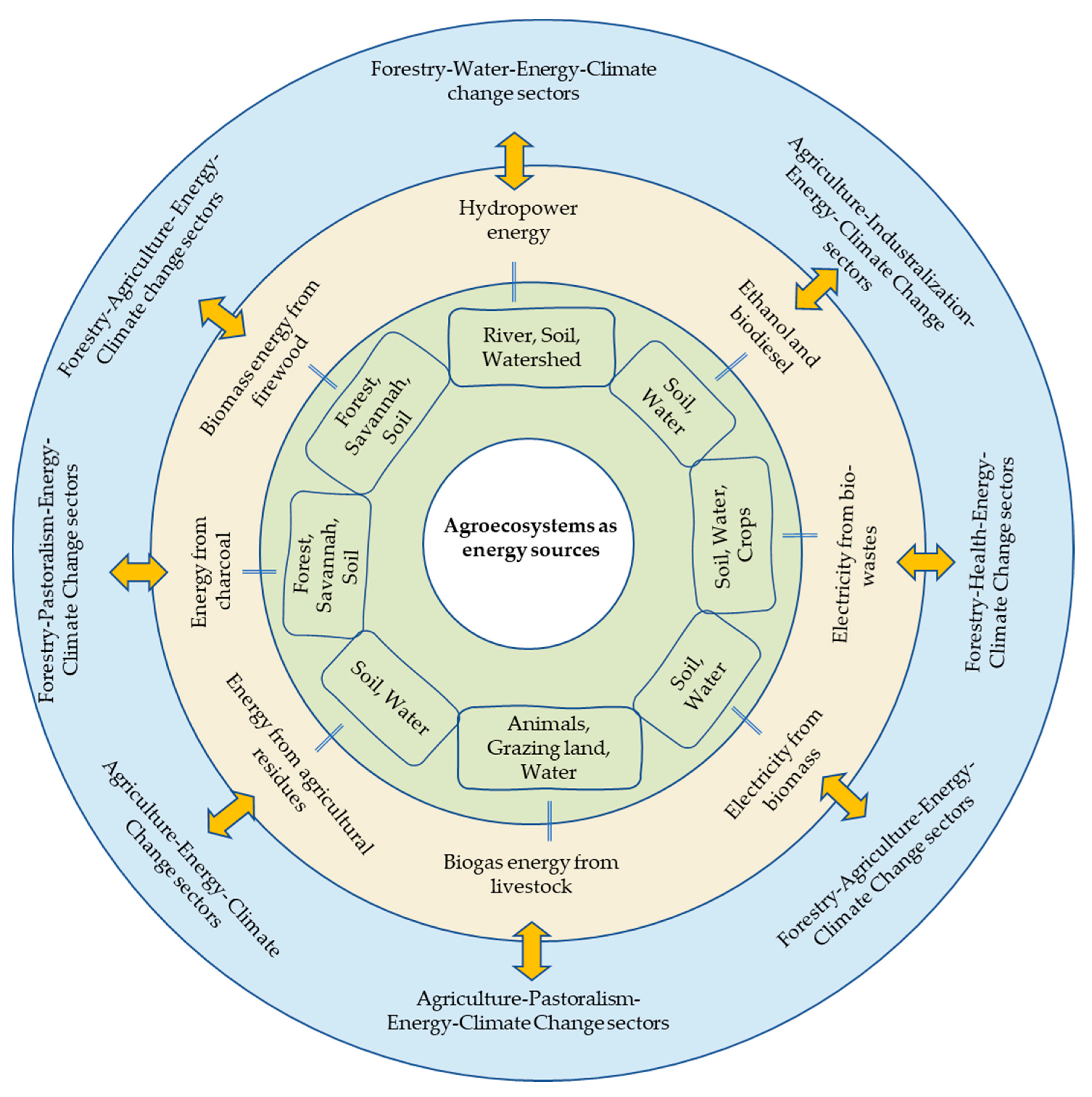
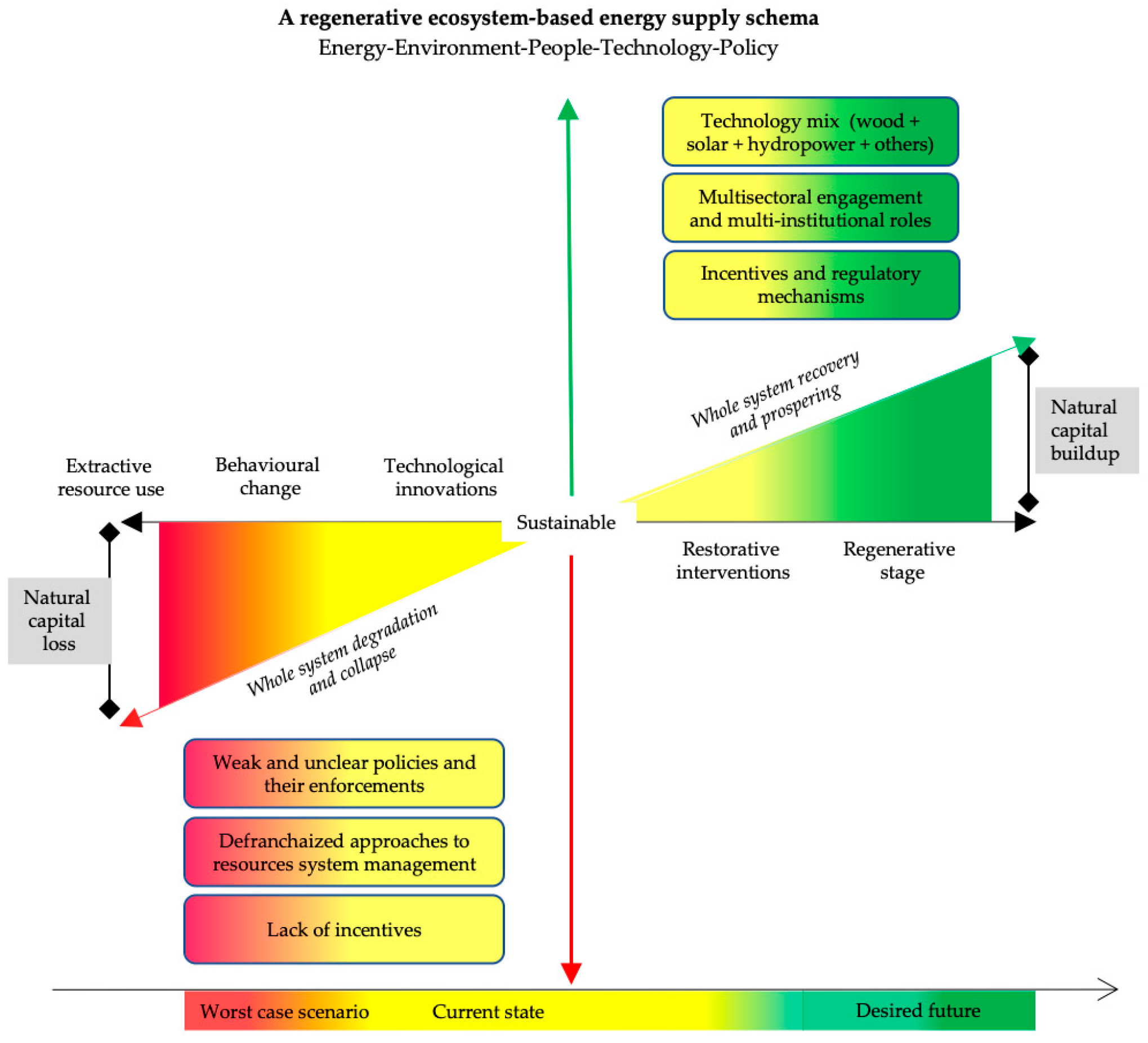
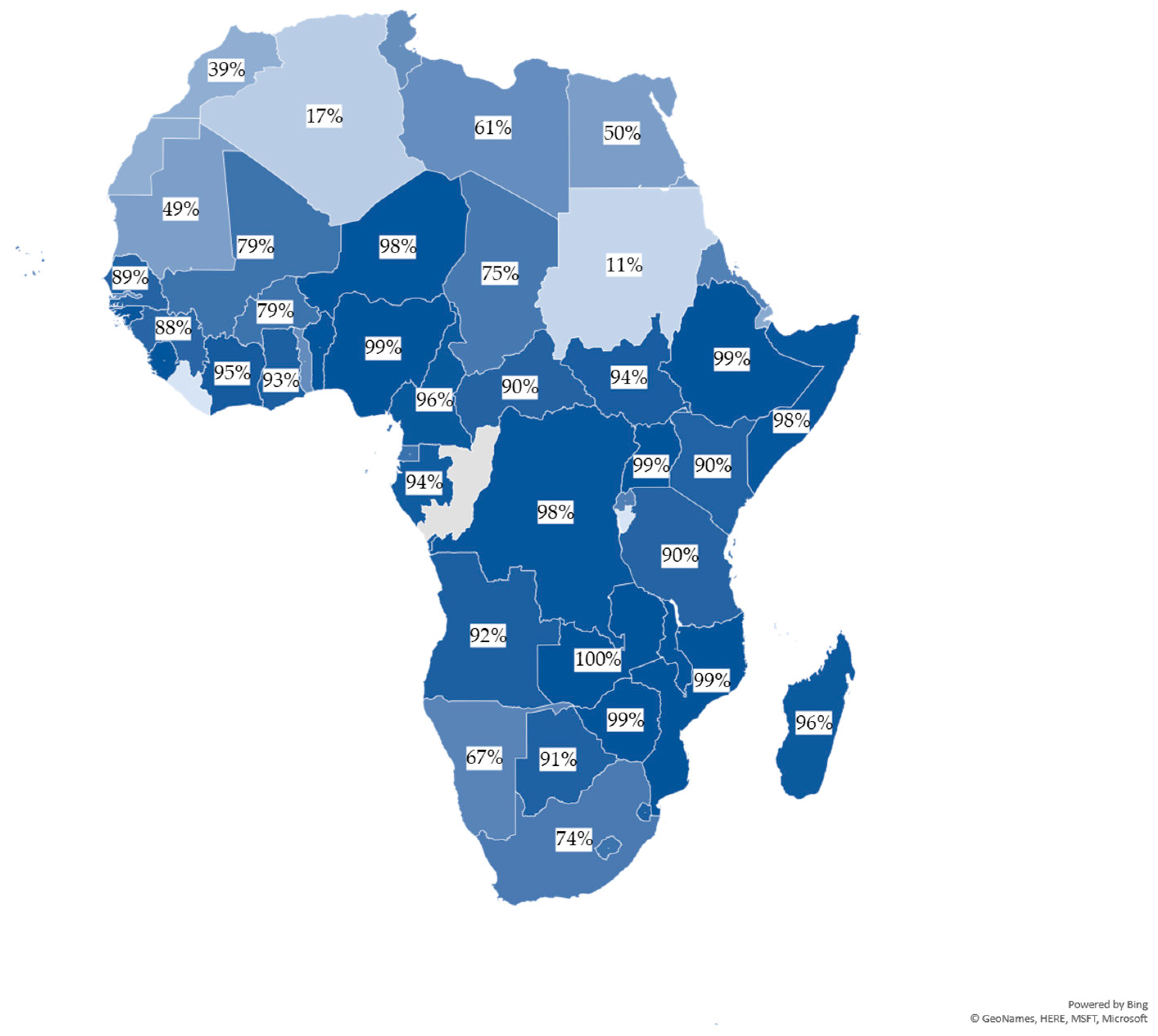

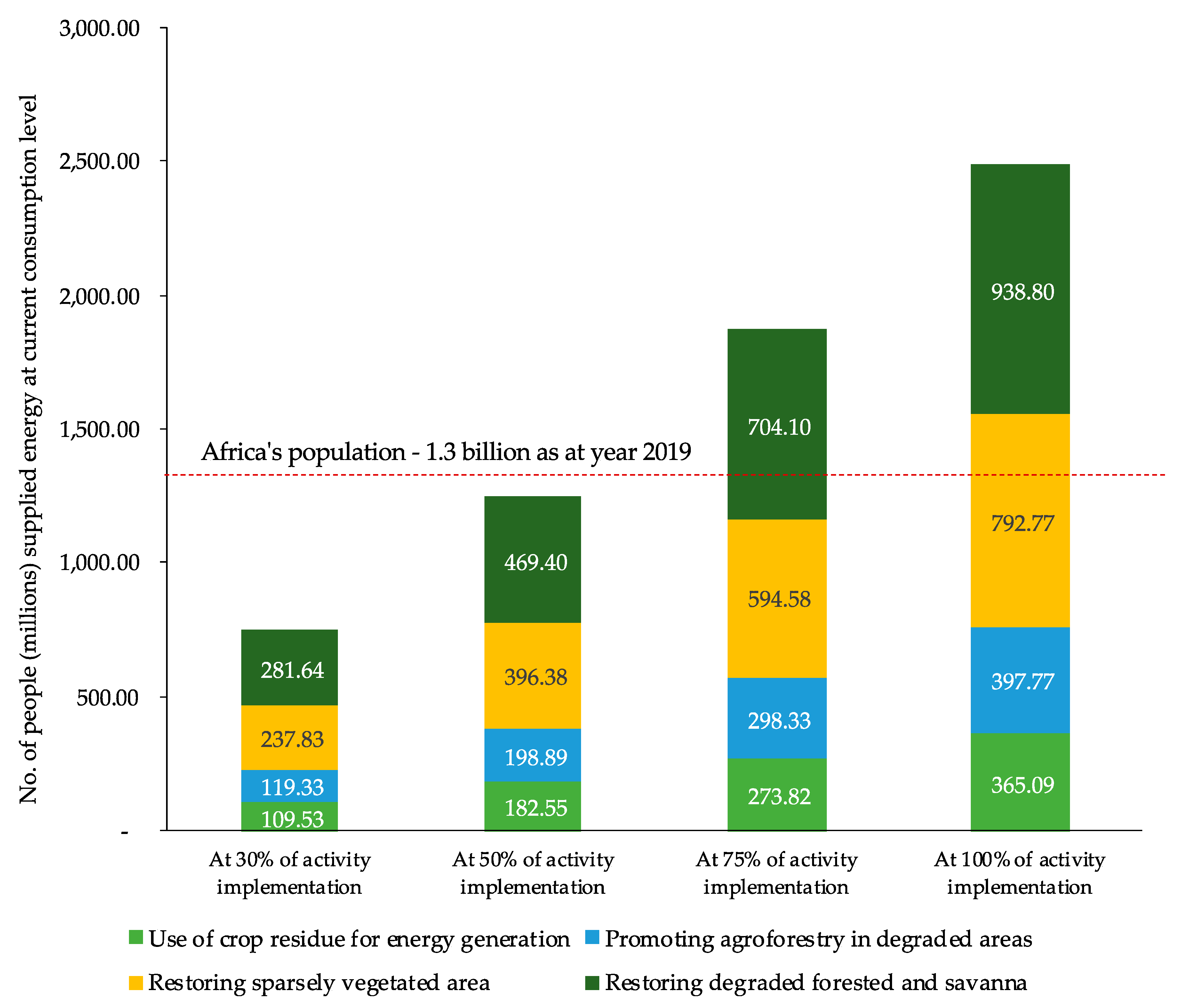
| Restoration Options | Annualized Emission Removal Rate (20 Years Range) (tCO2 ha−1 Year−1) [40] | Derived Biomass Equivalents (Tonnes a−1 Year−1) | ||
|---|---|---|---|---|
| Low | High | Low | High | |
| Option 1: Natural regeneration | 9.1 | 18.8 | 5.28 | 10.91 |
| Option 2: Agroforestry | 10.8 | 15.6 | 6.27 | 9.05 |
| Option 3: Plantation—Broad-leaved species (tropical dry) | 10.1 | 11.3 | 5.86 | 6.56 |
| Option 4: Plantation—Broad-leaved species (tropical humid) | 21.4 | 29.2 | 12.42 | 16.94 |
| Option 5: Plantation—conifers (tropical dry) | 36.2 | 41.2 | 21.01 | 23.91 |
| Option 6: Plantation—conifers (tropical humid) | 20.8 | 26.4 | 12.07 | 15.32 |
| Environmental Consequences | Description of Consequences or Impacts |
|---|---|
| Water | Disrupting the natural ecology of rivers by the plant establishment [55]. |
| Deteriorating water quality—untreated domestic waste and runoff from agricultural or industrial uses. Dams and reservoirs change natural water temperatures and water chemistry [56]. | |
| Siltation—due to intense rainfall with erodible soils. | |
| Eutrophication—the release of cyanotoxins since warm water conditions may accelerate the dynamics of the eutrophication process [57]. | |
| Soil | Soil erosion as runoff water carries away topsoil that is critical to produce food, feed, and fiber. |
| Atmosphere | The high amount of greenhouse gases released—industrialization leads to GHG emissions as well as other air pollutants. |
| Biodiversity | Damaging biodiversity—Hydropower dams can destroy habitats of aquatic life as well as inhibit the migration of fish [58]. |
| Landscape | Land use change—deforestation and clearing of land to set up hydropower plants, especially for large scale plants where dams need to be built. |
| Species | Growing Zones | Mean Annual Increment (m3) a | Calorific Value of Wood (KJ/gm) | Means of Propagation |
|---|---|---|---|---|
| Gliricidia sepiumb | Tropics | (2.84–3.19) [1,2,3] | 4.5 | Cuttings |
| Acacia mearnsiic | Tropics and subtropics | 10–25 [7,8,9,10] | 3.7 | Seed |
| Acacia niloticad | Tropics | 3–5 [15,16,17,18,19,20] | 4.9 | Seedlings |
| Acacia polyacantha | Wooded grassland, deciduous woodland | N.D. [15] | 4.0 | Seeds |
| Acacia xanthophloea | Tropical and subtropical savannah | 1.0–1.5 [20,21,22,23,24,25,26,27,28,29,30] | 4.4 | Seeds |
| Terminalia brownii | Arid, semi-arid, and sub-humid | N.D. | 4.6 | Seeds |
| Terminalia orbicularise | Arid regions | N.D. | 5.1 | Seeds |
| Commiphora africana | Dry savannahs | N.D. | 4.8 | Cuttings |
| Commiphora baluensisf | Arid, semi-arid rangelands | N.D. [10,11,12,13,14,15,16,17,18,19,20] | 4.4 | Seeds |
| Grevillea robustag | Riverine rainforest | 5–15 [8,9,10] | 4800 (kcal/kg) | Seeds and cuttings |
| Markhamia luteah | Lake basins and highland areas | 20 | N.D. | Seeds |
| Crop Type | Average Annual Production Quantity (2013–2018) (Tonnes) a | Energy Content (GJ/Tonne) b | Total Energy Potentially Generated (Million GJ) | Number of People That Could be Supported (In Million at 28.76 GJ/Year Per Person) |
|---|---|---|---|---|
| Maize | 76,864,066.67 | 12.46 | 2394.32 | 83.25 |
| Wheat | 26,988,158.50 | 17.00 | 1628.74 | 56.63 |
| Rice (paddy) | 31,443,454.67 | 13.45 | 1353.33 | 47.06 |
| Groundnuts | 13,405,968.50 | 18.80 | 1279.57 | 44.49 |
| Millet | 13,068,719.17 | 20.00 | 771.05 | 26.81 |
| Sorghum | 28,046,571.83 | 12.38 | 434.02 | 15.09 |
| Sugar cane | 93,947,959.83 | 16.60 | 389.88 | 13.56 |
| Potatoes | 25,468,619.33 | 17.50 | 361.02 | 12.55 |
| Barley | 6,747,087.83 | 17.00 | 349.84 | 12.16 |
| Coffee | 1,137,476.00 | 12.69 | 303.13 | 10.54 |
| Cow peas | 6,631,827.17 | 15.00 | 288.48 | 10.03 |
| Seed cotton | 4,467,497.50 | 17.65 | 279.92 | 9.73 |
| Soybeans | 2,748,016.17 | 15.00 | 232.48 | 8.08 |
| Cassava | 168,741,313.67 | 17.50 | 183.08 | 6.37 |
| Oil palm fruit | 18,957,246.17 | 13.26 | 106.83 | 3.71 |
| Coconuts | 2,050,956.17 | 17.40 | 61.38 | 2.13 |
| Beans | 6,572,401.50 | 16.00 | 52.58 | 1.83 |
| Sweet potatoes | 25,311,996.00 | 17.50 | 44.3 | 1.54 |
| Onions | 11,391,041.67 | 10.49 | 5.97 | 0.21 |
| Aggregate | 10,519.92 | 365.78 |
| Country | National Bioenergy Objective/Mission | Relevant Policies/Strategies |
|---|---|---|
| Ghana | Modernize and maximize the benefits of bioenergy on a sustainable basis. | Bioenergy Policy for Ghana, 2010 [69] |
| Kenya | Facilitating provision of clean, sustainable, affordable, competitive, reliable, and secure energy services at the least cost while protecting the environment | National Energy and Petroleum Policy, 2015 [70] |
| Rwanda | Switching from traditional to modern biomass energy sources that have socio-economic, health, and environment benefits. | Biomass Energy Strategy 2019–2030 [71] |
| Mozambique | Operationalizing the biofuel policy and strategy | Biofuel Sustainability Framework, 2014 [72] |
| South Africa | Stimulating rural development and reducing poverty by creating sustainable income-earning opportunities sector | Biofuels Industrial Strategy, 2007 [73] |
Publisher’s Note: MDPI stays neutral with regard to jurisdictional claims in published maps and institutional affiliations. |
© 2020 by the authors. Licensee MDPI, Basel, Switzerland. This article is an open access article distributed under the terms and conditions of the Creative Commons Attribution (CC BY) license (http://creativecommons.org/licenses/by/4.0/).
Share and Cite
Duguma, L.; Kamwilu, E.; Minang, P.A.; Nzyoka, J.; Muthee, K. Ecosystem-Based Approaches to Bioenergy and the Need for Regenerative Supply Options for Africa. Sustainability 2020, 12, 8588. https://doi.org/10.3390/su12208588
Duguma L, Kamwilu E, Minang PA, Nzyoka J, Muthee K. Ecosystem-Based Approaches to Bioenergy and the Need for Regenerative Supply Options for Africa. Sustainability. 2020; 12(20):8588. https://doi.org/10.3390/su12208588
Chicago/Turabian StyleDuguma, Lalisa, Esther Kamwilu, Peter A Minang, Judith Nzyoka, and Kennedy Muthee. 2020. "Ecosystem-Based Approaches to Bioenergy and the Need for Regenerative Supply Options for Africa" Sustainability 12, no. 20: 8588. https://doi.org/10.3390/su12208588
APA StyleDuguma, L., Kamwilu, E., Minang, P. A., Nzyoka, J., & Muthee, K. (2020). Ecosystem-Based Approaches to Bioenergy and the Need for Regenerative Supply Options for Africa. Sustainability, 12(20), 8588. https://doi.org/10.3390/su12208588








